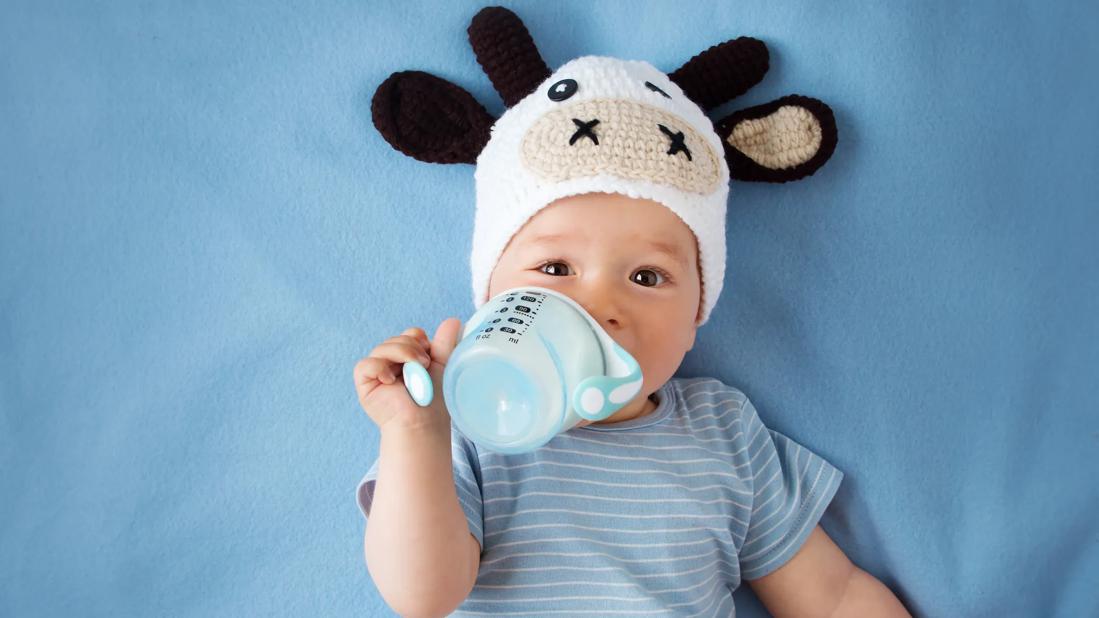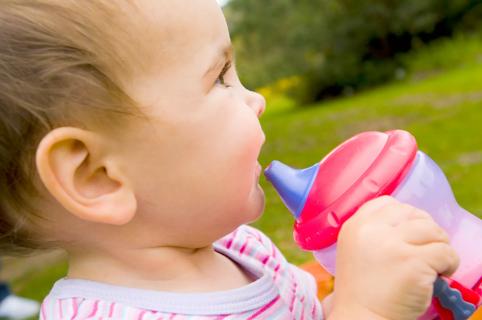In babies under 12 months old, cow’s milk has been associated with gastrointestinal bleeding

Babies drink breast milk and baby formula that’s specifically made to replicate breast milk — so, it may seem like babies should also be able to safely drink dairy milk, right?
Advertisement
Cleveland Clinic is a non-profit academic medical center. Advertising on our site helps support our mission. We do not endorse non-Cleveland Clinic products or services. Policy
Not so fast.
“Avoid feeding cow’s milk to any child younger than 12 months old,” states pediatrician Kimberly Churbock, MD. And they shouldn’t have other kinds of milk, either — even the kinds that come from almonds, oats and soy.
She explains why cow’s milk and other types of milk aren’t fit for your baby’s diet, and when it’s safe to introduce them.
“Until your child is a year old, the only kind of milk they should have is breast milk and/or properly prepared, iron-fortified infant formula,” Dr. Churbock reiterates.
But why, exactly? Cow’s milk is associated with health risks in babies:
Advertisement
For the first six months of their lives, most babies should get all of their nutrition from breast milk and/or formula. At that point, you can start introducing solid foods. Turn to your pediatrician for individual advice based on your child’s health needs.
A few foods that adults eat aren’t good for babies, including various types of milk.
“In addition to avoiding cow’s milk, you shouldn’t give goat’s milk or milk alternatives (like soy milk or almond milk) to infants under 12 months,” Dr. Churbock states. “They’re not optimal for your child’s development and growth.
Even after your child has hit age 1, it’s best to stay away from flavored milk (and milk alternatives), like those that come in chocolate, vanilla or strawberry varieties. They add extra sugar that kids not only don’t need, but also really shouldn’t have.
In fact, the American Academy of Pediatrics recommends that children under 2 consume no added sugar at all, and children 2 and older should have no more than 25 grams (or 6 teaspoons) of added sugar per day.
Cow’s milk isn’t safe for babies under 12 months, but the same rules don’t necessarily apply to other dairy products.
“You can typically introduce cheese and plain yogurt to infants younger than 1 year of age,” Dr. Churbock clarifies. “Just be sure to consult with your pediatrician if your child has a milk protein intolerance or milk allergy.”
She says it’s also generally OK to use small amounts of milk to cook or to prepare other infant-appropriate foods.
After age 1, it’s safe — and recommended — to start incorporating milk into your child’s diet, especially if they’re starting to transition away from breast milk and/or formula.
“From ages 1 to 2, babies should be given plain whole cow’s milk, which has the right balance of nutrients for their needs,” Dr. Churbock says. “If your child has a milk allergy or other issues with cow’s milk, your pediatrician or a registered dietitian can suggest the healthiest, safest nutrition plan.”
So, where should you start? She shares some tips:
Advertisement
Once your child reaches age 2, ask your pediatrician what kind of milk your child should be drinking. Older toddlers should typically switch to fat-free or 1% dairy products, which provide the same nutrients but with less fat.
Advertisement
Learn more about our editorial process.
Advertisement

No juice until your child is 1 year old — and even then, they shouldn’t have much, if any

Ultimately, the choice depends on what works best for you and your baby, but it’s also important to be aware of the pros and cons of both

Ideally, you want your toddler to be drinking from a ‘big kid cup’ by age 2

Letting your baby feed themself foods the whole family enjoys has its benefits — but stick to softer foods and follow safe-eating guidelines

Levels are generally low, but there are ways to minimize potential health risks

Slowly introducing cow’s milk (or soy milk) can help your child make the change

In babies under 12 months, honey may cause a serious illness called infant botulism

A daily dose of vitamin D can help babies build strong bones, as well as boost their brain development

The ‘sunshine vitamin’ is found naturally in some fish and is added to other foods

Autism and ADHD often go hand in hand, giving rise to the term AuDHD

The Yuzpe regimen is less effective than other forms of emergency contraceptives, and it’s associated with more side effects